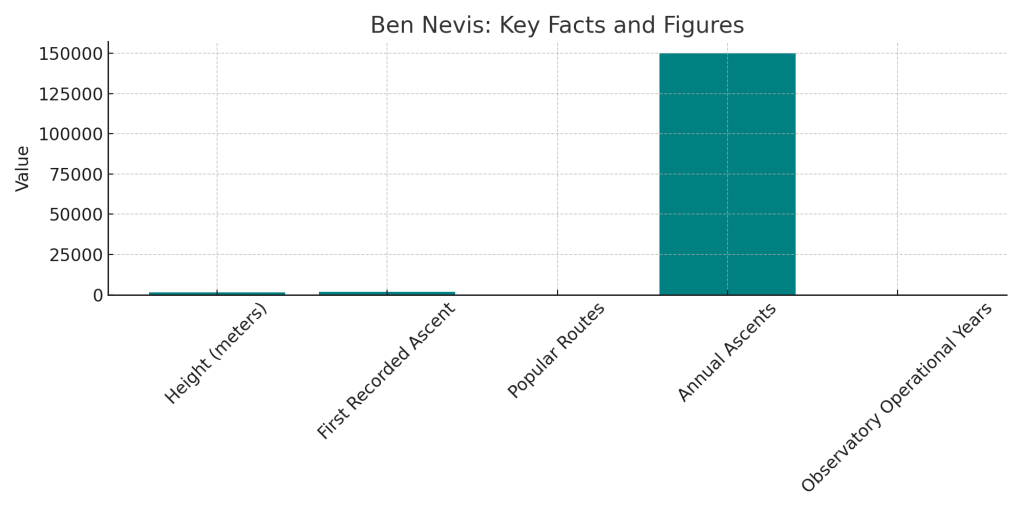The United Kingdom may not be known for its towering peaks like the Himalayas or the Rockies, but it is home to its own unique and awe-inspiring mountains. Topping the list as the tallest of them all is Ben Nevis, a Scottish giant that holds a special place in the hearts of hikers, climbers, and nature enthusiasts.
Standing proudly in the Scottish Highlands, Ben Nevis reaches an impressive height of 1,345 meters (4,413 feet) above sea level. While this may not compete with some of the world’s tallest peaks, it certainly ranks as the highest mountain in the UK. Located near the town of Fort William in Scotland, it draws visitors from all over the world who seek adventure and natural beauty.

Unique Aspects and Historical Significance of Ben Nevis
Popularity and Climbing Routes
Ben Nevis, towering at 1,345 meters (4,413 feet), is not only the tallest mountain in the UK but also a significant tourist attraction with approximately 150,000 ascents made each year. The most frequented route to its summit is the Pony Path, also known as the Tourist Path or Mountain Track, which is accessible to hikers of varying skill levels.
First Ascent and Historical Misconception
The first recorded ascent of Ben Nevis was by a botanist named James Robertson in 1771, who climbed it for botanical research. Interestingly, until 1847, the mountain was not recognized as Scotland’s highest peak, with many believing that Ben Macdhui held this title.
Meteorological Importance
The Ben Nevis Observatory, established in 1883 and now abandoned, was a pioneering meteorological station. As the highest man-made structure in Britain at the time, it played a crucial role in early weather observation and scientific research.
Wildlife and Ecosystem
Surrounding Ben Nevis is a rich and diverse ecosystem, offering a habitat to various wildlife species. This natural aspect adds to the mountain’s allure for nature enthusiasts and scientists alike.
Unusual Historical Events
Ben Nevis has witnessed some unique occurrences. In 1911, a Model T Ford was driven to the summit as part of a publicity stunt. In a more whimsical event, the remnants of a piano were found near the summit in 2008, left from a charity event carried out in 1971.
These distinctive features and historical facts underline Ben Nevis’s role not just as a natural wonder but also as a cornerstone of Scottish cultural and scientific history
Ben Nevis Geological Origins
To truly appreciate the grandeur of Ben Nevis, it’s essential to understand its geological history. Ben Nevis is part of the Grampian Mountain Range, which formed over 400 million years ago during the Caledonian Orogeny. This mountain-building event brought together land masses that would eventually become Scotland and Scandinavia. Over eons, the forces of erosion shaped these mountains, carving out valleys and leaving behind rugged peaks like Ben Nevis.
Climbing Ben Nevis
Hiking or climbing Ben Nevis is an unforgettable experience, and it caters to various skill levels. The most popular route to the summit is the Pony Track, also known as the Tourist Path. This path is well-maintained and relatively easy to follow, making it suitable for beginners. However, don’t let the “tourist” label fool you; the climb still requires preparation and respect for the mountain’s challenges.
For those seeking more adventure, the Carn Mor Dearg Arete and the CMD (Carn Mor Dearg) Route offer a more challenging ascent. These routes are less crowded but require more technical skills and are not recommended for beginners. As with any mountain climb, it’s crucial to check the weather conditions and be prepared for rapidly changing weather, especially in Scotland.
The Ben Nevis Challenge
The Ben Nevis Challenge is a popular quest for hikers and adventurers. It involves ascending and descending Ben Nevis in a single day, often combining it with climbs of the two other highest peaks in the UK: Scafell Pike in England and Snowdon in Wales. This challenge, known as the Three Peaks Challenge, is not for the faint of heart. It’s a test of endurance and navigation skills, and participants often undertake it to raise money for charity.
Ben Nevis Wildlife
The region around Ben Nevis is teeming with wildlife, providing a rich and diverse ecosystem. The mountain itself is home to various bird species, including ptarmigans and golden eagles. Additionally, the slopes and surrounding areas are inhabited by deer, foxes, and the elusive Scottish wildcat.
In the summer months, the lower slopes of Ben Nevis burst into color with a carpet of alpine plants and wildflowers, such as saxifrages and mountain avens. This is also a prime time for spotting butterflies and other insects that thrive in the brief Scottish summer.
Historical Significance
Ben Nevis is not just a natural wonder; it also has historical significance. The mountain has played a role in Scotland’s history for centuries. In Gaelic, it is known as “Beinn Nibheis,” and it holds cultural importance in Scottish folklore and traditions.
During the 18th and 19th centuries, Ben Nevis was a center of industry due to its rich mineral deposits. Lead and copper were mined from its slopes, and the ruins of the mining operations can still be seen today. The construction of the Pony Track, the most popular hiking route, was also initiated during this time to support meteorological and surveying activities.
The Observatory
One of the more intriguing aspects of Ben Nevis’s history is the observatory that once stood on its summit. Built-in 1883, the Ben Nevis Observatory served as a weather station and research facility. The observatory was manned year-round, even in the harshest winter conditions.
The work conducted at the observatory contributed significantly to our understanding of mountain weather patterns. Sadly, the observatory was closed in 1904, but its ruins still stand as a reminder of the scientific endeavors that took place on the summit of Ben Nevis.
The View from the Summit
Reaching the summit of Ben Nevis is a breathtaking experience in more ways than one. On a clear day, the panoramic views from the top are nothing short of spectacular. To the west, you can see the Atlantic Ocean, while to the east lies the stunning Loch Linnhe. On exceptionally clear days, it’s even possible to catch a glimpse of the distant Isle of Skye.
Unique Challenges of Climbing Ben Nevis
Climbing Ben Nevis comes with its own set of unique challenges, primarily due to its location in the Scottish Highlands. One of the most significant factors to consider is the weather. Scotland is notorious for its unpredictable weather, which can change rapidly. Even in summer, snow can be encountered on the summit, making it essential to be well-prepared with warm clothing, waterproofs, and sturdy footwear.
Another challenge is the potential for poor visibility. Fog and mist can descend quickly on the mountain, reducing visibility to almost zero. This is why it’s crucial to carry navigational equipment, such as a map, compass, and GPS device, and to be proficient in their use.
Safety Precautions
Safety should always be a top priority when attempting to climb Ben Nevis or any other mountain. Here are some essential safety precautions to keep in mind:
- Check the weather forecast before your ascent, and be prepared for changing conditions.
- Inform someone of your plans, including your expected return time.
- Dress in layers to stay warm and dry. Hypothermia is a real risk, even in summer.
- Carry enough food and water to sustain you during the climb.
- Navigation tools, such as a map and compass, are vital for route finding.
- If you’re not an experienced hiker or climber, consider hiring a guide or joining a guided group.
Conservation Efforts
With its popularity as a hiking destination, Ben Nevis faces environmental challenges. The fragile ecosystem can be easily disrupted by hikers who stray from established paths or leave litter behind. To combat these issues, various conservation organizations, such as the John Muir Trust, work tirelessly to protect the mountain’s natural beauty.
Visitors are encouraged to follow the “Leave No Trace” principles, which include disposing of waste responsibly, staying on designated trails, and respecting the local flora and fauna. By doing so, we can help ensure that future generations can continue to enjoy the pristine wilderness of Ben Nevis.
Accommodation and Services
Fort William, the nearest town to Ben Nevis, serves as a hub for visitors. It offers a range of accommodation options, from campsites and hostels to hotels and bed and breakfasts. The town also boasts numerous outdoor equipment shops and restaurants, making it an ideal base for those planning to climb Ben Nevis.
In addition to accommodations, Fort William offers various services, including medical facilities, transportation options, and guided tours. It’s a convenient starting point for anyone embarking on a Ben Nevis adventure.
The Beauty of Ben Nevis in All Seasons
Ben Nevis offers a different experience in every season. While summer is the most popular time for hiking, each season has its own unique charm:
- Spring: Springtime brings blooming flowers and milder temperatures, making it an excellent time for a hike.
- Summer: The summer months provide the best chance for clear skies and warm weather. However, this is also the busiest time on the mountain.
- Autumn: The changing colors of the surrounding landscape make autumn a picturesque time to visit.
- Winter: For experienced mountaineers, the challenge of Ben Nevis in winter is an entirely different adventure, with ice and snow adding a level of difficulty.
Stories and Legends
Like many prominent mountains, Ben Nevis is steeped in stories and legends. In Scottish folklore, it is sometimes referred to as the “Hollow Mountain.” Legends tell of a secret entrance to the fairy kingdom within the mountain, accessible only to those with pure hearts.
In more recent times, Ben Nevis has also been the setting for adventure stories, from daring rescues to remarkable feats of endurance. These tales add to the mountain’s mystique and inspire those who venture to its heights.
Ben Nevis as a Symbol
Ben Nevis is more than just a mountain; it’s a symbol of Scotland’s wild and untamed beauty. Its rugged terrain and ever-changing weather make it a place of challenge and discovery. Many Scots and visitors alike find a deep connection with this iconic peak, and for some, climbing it is a lifelong dream.
Conclusion
Ben Nevis, the tallest mountain in the UK, is a natural wonder that offers adventure, beauty, and a sense of accomplishment to those who seek it. Its geological history, diverse wildlife, and rich cultural significance make it a destination worth exploring. Whether you’re an experienced mountaineer or a novice hiker, Ben Nevis has something to offer everyone.
Just remember to be prepared, respect the environment, and savor the journey to the top of this Scottish giant. It’s an experience you won’t soon forget.










